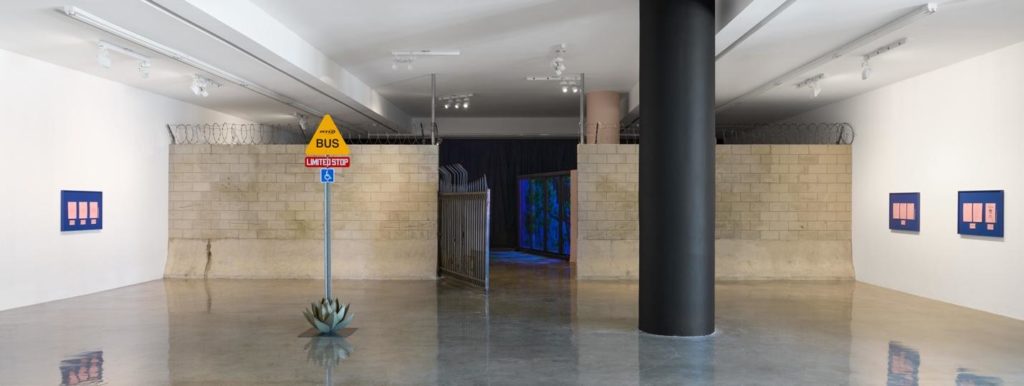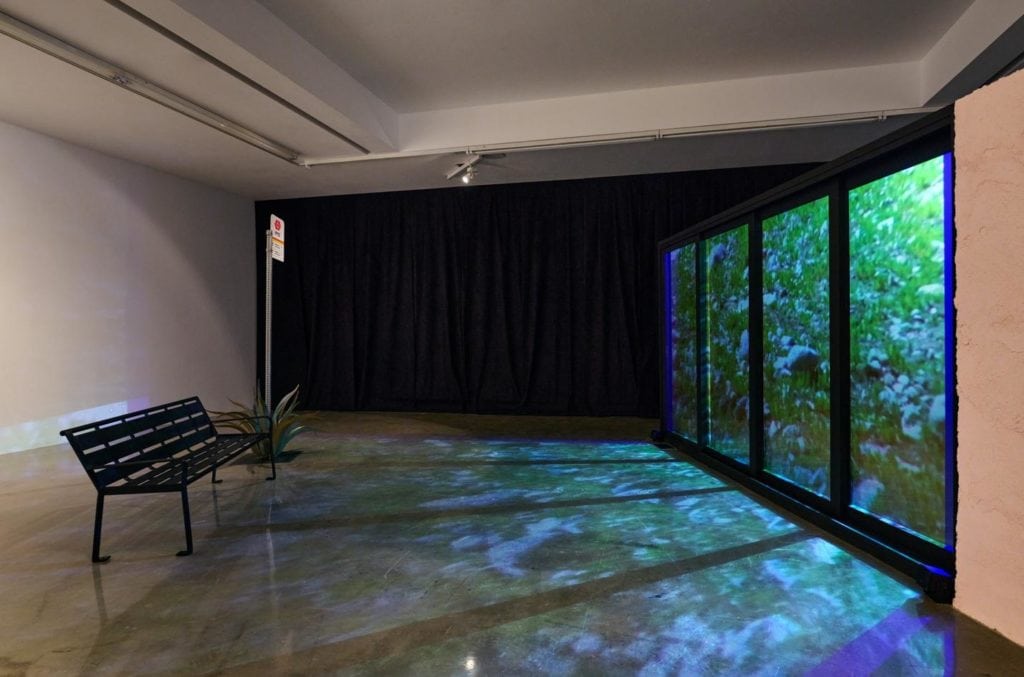Shaper of God is on display through October 4, 2022
CalArts’ REDCAT gallery displays a small but notable exhibition called Shaper of God by American Artist. Artist, who legally changed their name in 2013, aptly de-centers what might be their own artistic style. Rather, they artistically engage with the writer Octavia Butler. The exhibition negotiates with space and land, brushing upon a history of rocket testing in the Arroyo Seco Canyon in Pasadena, as well as Butler’s science fiction. Butler, one of the great science fiction writers of her generation, was profoundly concerned with the intertwining forces of the environment, race, capital and power, and the exhibition unsurprisingly shares those concerns. It is a small yet encompassing spatial arrangement. Rather than collecting a series of art pieces, Artist extrapolates a vision from the California of Butler’s Parable of the Sower to engage with her in a collaboration of artistic form. They bring together sculpture, video, science fiction, and writing to meditate on world-making as modes of responding to a precarious world.

AASoG_Install01-22
American Artist: Shaper of God, installation view, REDCAT, Los Angeles, May 28 – October 2, 2022. Photo: Brica Wilcox, courtesy of REDCAT, Los Angeles.
Butler, native to Altadena (as is American Artist), is, of course, crucial to reading the context of the exhibition. She could be characterized as mysterious, describing herself as “comfortably asocial—a hermit in the middle of Los Angeles.” Despite the highway delineated sprawl of Los Angeles, Butler never drove, always taking public transportation to what she might have called her office at the downtown branch of the Los Angeles Public Library. It was there that she compiled swathes of research, news clippings and notes on current events, politics, and ideas for her fiction. Artist’s exhibition highlights some reproductions of her notes, demonstrating her actively speculating artistic process. The Parables are Butler’s realist dystopian novels. They take place in the 2020s and attempt to imagine a logical progression of futurity. Unsurprisingly, they are packed with prescience regarding the state of climate change, politics, the wealth gap, and how space – both public and private – becomes demarcated. Butler was paying close attention to national and local politics, presumably aware of the histories of the Arroyo Seco that American Artist touches on. Scholar Shelley Streeby has dug deep into Butler’s archives at the Huntington Library in Los Angeles, and her research highlights Butler’s notes, showcasing just how responsive her work was to the world she observed. Indeed, the Parables were rather impassioned responses to Reagan era corruption, racism, and deregulation, particularly regarding environmental protection.

AA08a-d
American Artist, Robledo Community Wall (Olamina cul-de-sac), 2022. Steel, cement, stucco, wood, razor wire, paint. Courtesy of the artist and Commonwealth and Council, Los Angeles. Photo: Brica Wilcox, courtesy of REDCAT, Los Angeles.
Sower begins the story in the walled off town of Robledo, in which protagonist Lauren Oya Olamina and her community are protected from an outside world of lawlessness, crumbling infrastructure, and pyromaniac drug addicts. Robledo is quickly destroyed, the walls proving to be inadequate, and Lauren travels up the coast. She picks up compatriots and attempts to grow the quasi-religious Earthseed belief system Artist takes their title from. In Sower, Lauren is concerned with theorizing a new relationship with God, but she and Butler are both also concerned with the shifting, often decaying landscapes affected by climate-change and used by humans. Lauren’s use of Earthseed is always a form of world-making that attempts to see the world as a place that can be shaped toward a better future. Artist’s sculptures visualize Robledo by changing the gallery space into a haunting, walled entryway. A gate can be entered to view a clip created by the Robledo Historical Society which details a brief history of the fictional town. The space is then highlighted and surrounded by street signs, metal sculptures of agave plants, and a large bench. The signs denote actual streets that Butler traversed, and the environment made to reflect her Altadena.
Just as Butler’s work harnessed science fiction as a response to world issues, American Artist reflects on the blending of art, life, fiction, and nonfiction. Here, fictional space is given realization in physical form, while a real space of the past is resurrected, and the two combine to blur the boundaries of reality. This blending of space, by blurring fiction and reality, also activates commentary on the genre of science fiction. By realizing the space of Robledo, Artist gives visualization to the world-making mechanisms of the genre. Science Fiction is adept at generating new worlds within which humans can inhabit a space that hinges both on difference and reflection of our own world. There is something particularly claustrophobic about this combination of spaces. It is one that is clearly meant to feel unnatural. The walls themselves are haunting and intimidating, while the gallery walls are sparsely populated, allowing focus on the framed notes from Butler’s archive to be shown off. They are life-sized, mimicking real outdoor space to be navigated through, rather than gazed upon. The clear artifice of blending outdoor and indoor spaces spurns us to reflect on the artifice of how humans attempt to organize and develop space.

In the middle of the gallery space, a film is projected onto a screen. It is a mockumentary style advertisement of Robledo, which is based loosely on Altadena, showcasing historical images of California landscapes and wildlife. The Robledo of the novel is, at first, a protected town, one that is meant to foster a community in the wake of the wide scale communal crumbling and isolation. The walls speak to the ironic illusions idealized by barriers. They appear intimidating, but in Butler’s world, they fail rather miserably. The mockumentary plays on that illusion, nodding toward the natural surroundings of the Southern California landscape. At one point, the narrator describes the agave plants populating the region. He characterizes them as tough, intimidating complements to the land, asserting that they function as barriers. Man-made barriers, according to the narrator, can only balk at the power of the agave plants.

AA01
American Artist, To Acorn, 2022. Steel, acrylic, hardware. 30 x 30 x 108 in. Courtesy of the artist and Commonwealth and Council, Los Angeles. Photo: Brica Wilcox, courtesy of REDCAT, Los Angeles.
The agave plants are exemplary of the ecological history painted by Artist’s spatial imagination. They touch on the story of rocket testing in the Arroyo Seco canyon to reflect on histories of land use and scientific development. That history was one of many government-sanctioned acts that were meant to be hushed to the public, while actively taking and exploitation of public lands. Robledo’s agave plants stand as symbols of resilient nature, unwilling to yield to the human illusion of control over the natural world. By raising these conversations through Butler’s work, Artist reflects on her prophetic imaginings of a world warped by climate change. In the Parables, towns and cities are shaped and melded by increasingly frequent natural disasters. The protection that the citizens of Robledo believe they have from these human constructed walls dissipates with the snap of a finger. The artifice of Artist’s sculpture is the artifice of man-made barriers.

AA05
American Artist, Octavia E. Butler Papers: mssOEB 1-9062 I (Mother to Daughter), 2022. Huntington Library stationary, graphite, pencil, felt. 26 x 371⁄2 in (66 x 95 cm) (framed). Courtesy of the artist and Commonwealth and Council, Los Angeles. Photo: Brica Wilcox, courtesy of REDCAT, Los Angeles.
Artist’s choice to present reproductions of Butler’s notes as pieces of the exhibition points toward the value of Butler’s artistic presence. One note is a summary from the drafting stages of Parable of the Sower. She describes the world of 2020, in which lawlessness has grown, climate change has wracked the land, and homelessness abounds. Her protagonist, Lauren, sees what is around her and hopes to shape a vision, first of God, then of the world. As Lauren’s story unfolds, violence and struggle are plentiful, but her character maintains a remarkable ability to bring people together and to bring them hope. Critics are undecided on how bleak the imagined world of Butler’s novels ends up being, but readers like me and American Artist maintain that her vision can inject some imagination into how we read the world. The exhibition champions Butler, science fiction, and the imaginative, world-making power of art making practices.